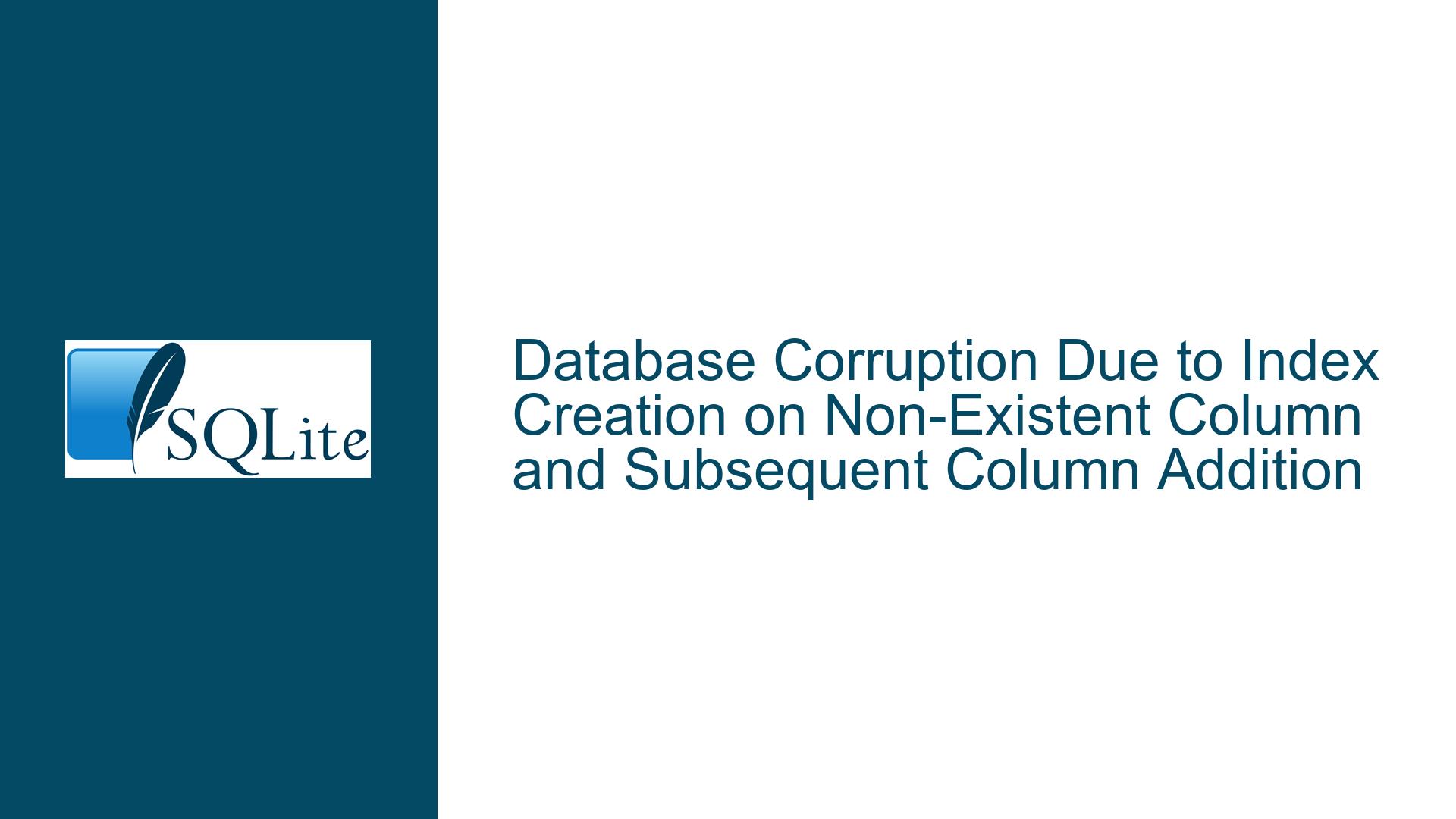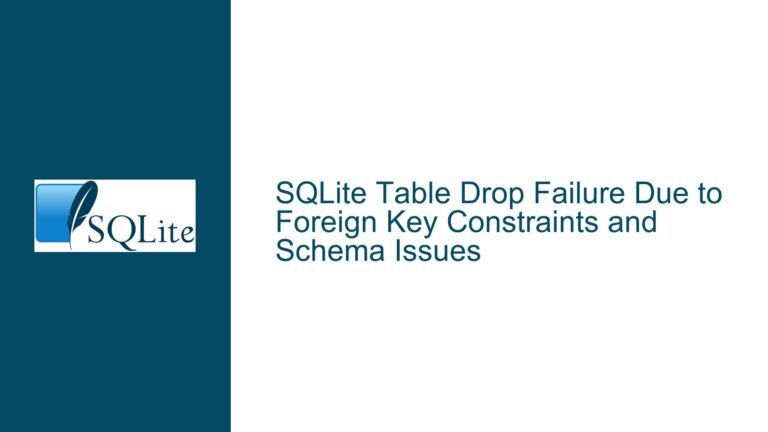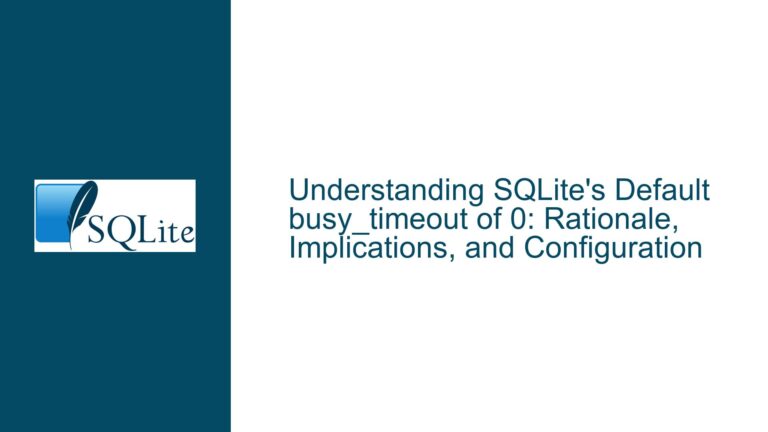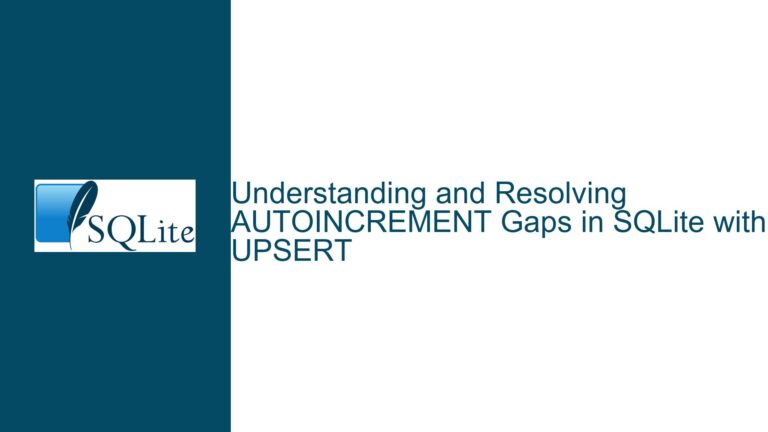Database Corruption Due to Index Creation on Non-Existent Column and Subsequent Column Addition
Issue Overview: Database Corruption from Index Creation on Non-Existent Column
The core issue revolves around a sequence of SQL operations that lead to database corruption in SQLite. The problematic sequence involves creating a table, inserting data into it, attempting to create an index on a non-existent column, and subsequently adding that column. Instead of SQLite throwing an error for attempting to create an index on a non-existent column, the operation proceeds without immediate error. However, this leads to a corrupted database state, as evidenced by the PRAGMA integrity_check command reporting "row 1 missing from index IX" for each row in the table. This corruption persists until the index is dropped and recreated.
The SQL statements involved are as follows:
CREATE TABLE a (
"Field1" INTEGER
);
INSERT INTO a (field1) VALUES ('0');
CREATE INDEX "IX" ON "a" (
"field2"
);
ALTER TABLE a ADD COLUMN field2 INTEGER;
PRAGMA integrity_check;
At first glance, the issue appears to be a violation of SQLite’s expected behavior, where creating an index on a non-existent column should result in an error. However, the operation proceeds, and the database enters a corrupted state. This behavior is particularly problematic because it bypasses the usual safeguards that prevent such inconsistencies, leading to a situation where the database’s integrity is compromised without immediate detection.
The corruption manifests when the PRAGMA integrity_check command is executed, revealing that rows are missing from the index. This indicates that the index is not properly aligned with the table’s data, a situation that can lead to incorrect query results, failed transactions, and other undesirable outcomes. The corruption is not immediately apparent, as the initial operations complete without error, making it a silent issue that can go unnoticed until integrity checks are performed.
Possible Causes: Double-Quoted String Misfeature and SQLite’s Handling of Non-Existent Columns
The root cause of this issue lies in SQLite’s handling of double-quoted identifiers and its behavior when encountering non-existent columns during index creation. Specifically, the problem is tied to the "double-quoted string misfeature," a known quirk in SQLite where double-quoted strings are interpreted as identifiers rather than string literals under certain conditions. This misfeature can lead to unexpected behavior, particularly when dealing with column names and index creation.
In the provided SQL sequence, the column name "field2" is enclosed in double quotes within the CREATE INDEX statement. When SQLite encounters this, it interprets "field2" as an identifier rather than a string literal. However, since field2 does not exist at the time of index creation, SQLite should ideally throw an error. Instead, due to the double-quoted string misfeature, the operation proceeds, and the index is created on a non-existent column. This creates a mismatch between the index and the table’s data structure, leading to corruption.
The issue is further compounded when the ALTER TABLE statement is executed to add the field2 column. At this point, the table’s structure changes, but the existing index IX is not automatically updated to reflect this change. As a result, the index remains out of sync with the table, leading to the "row missing from index" errors reported by PRAGMA integrity_check.
Another contributing factor is SQLite’s leniency in handling certain types of errors. Unlike some other databases that enforce strict schema validation, SQLite allows certain operations to proceed even when they involve non-existent columns or other inconsistencies. This leniency can be beneficial in some scenarios but can also lead to subtle issues like the one described here.
The version of SQLite in use (3.35.5) also plays a role. While this version includes many improvements and bug fixes, it may still exhibit certain quirks, especially when dealing with edge cases like the one described. Recompiling SQLite with the -DSQLITE_DQS=0 flag, as suggested by Richard Hipp, disables the double-quoted string misfeature and can prevent this issue from occurring. However, this requires a custom build of SQLite, which may not be feasible in all environments.
Troubleshooting Steps, Solutions & Fixes: Addressing Database Corruption and Preventing Future Issues
To resolve the issue of database corruption caused by creating an index on a non-existent column and subsequently adding that column, several steps can be taken. These steps include immediate fixes to address the corruption, preventive measures to avoid similar issues in the future, and best practices for database schema management.
Immediate Fixes:
Drop and Recreate the Index: The most straightforward solution is to drop the corrupted index and recreate it after the column has been added. This ensures that the index is properly aligned with the table’s data structure. The following SQL statements can be used:
DROP INDEX "IX"; CREATE INDEX "IX" ON "a" ( "field2" );This approach resolves the immediate issue of corruption but does not address the underlying cause.
Run Integrity Checks and Repair: After dropping and recreating the index, it is essential to run
PRAGMA integrity_checkagain to ensure that the database is in a consistent state. If any additional issues are detected, further repairs may be necessary. In some cases, it may be necessary to export the data, recreate the database from scratch, and re-import the data to ensure complete integrity.
Preventive Measures:
Disable Double-Quoted String Misfeature: To prevent similar issues from occurring in the future, consider recompiling SQLite with the
-DSQLITE_DQS=0flag. This disables the double-quoted string misfeature and ensures that double-quoted strings are always treated as string literals rather than identifiers. This can be done by modifying the SQLite build configuration and recompiling the library.Use Explicit Schema Validation: When creating indexes or modifying table schemas, explicitly validate the existence of columns before performing operations. This can be done using SQL queries to check the
sqlite_mastertable for column definitions. For example:SELECT name FROM pragma_table_info('a') WHERE name = 'field2';If the column does not exist, the operation should be aborted or the column should be added before creating the index.
Enable Strict Mode: SQLite 3.37.0 introduced a strict mode that enforces stricter schema validation. Enabling strict mode can help prevent issues like the one described by ensuring that operations involving non-existent columns or other inconsistencies are rejected. To enable strict mode, use the following command:
PRAGMA strict=ON;
Best Practices for Database Schema Management:
Avoid Using Double-Quoted Identifiers: To minimize the risk of encountering issues related to the double-quoted string misfeature, avoid using double-quoted identifiers in SQL statements. Instead, use unquoted or single-quoted identifiers where possible. For example:
CREATE INDEX IX ON a ( field2 );Perform Schema Changes in a Controlled Manner: When making schema changes, such as adding columns or creating indexes, perform these operations in a controlled manner. This includes validating the schema before and after changes, running integrity checks, and testing the changes in a development environment before applying them to production.
Use Transactions for Schema Modifications: When performing schema modifications, use transactions to ensure that changes can be rolled back in case of errors. This helps maintain database integrity and prevents partial changes from causing corruption. For example:
BEGIN TRANSACTION; ALTER TABLE a ADD COLUMN field2 INTEGER; CREATE INDEX IX ON a ( field2 ); COMMIT;Regularly Monitor Database Integrity: Regularly run
PRAGMA integrity_checkto monitor the integrity of the database. This helps detect and address issues early, before they lead to more significant problems. Consider automating this process as part of routine database maintenance.
By following these troubleshooting steps, solutions, and fixes, you can address the immediate issue of database corruption and implement preventive measures to avoid similar issues in the future. Additionally, adopting best practices for database schema management will help ensure the long-term integrity and reliability of your SQLite databases.






